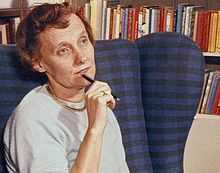Emil i Lönneberga
Emil of Lönneberga (from Swedish: Emil i Lönneberga) is a series of children's novels by Astrid Lindgren, covering twelve books written from 1963 to 1997. Emil, the title character, is a prankster who lives on a farm in the district of Lönneberga in Småland, Sweden. The books have been published in 44 languages.[1] In most translations, the original illustrations by the Swedish illustrator Björn Berg are used.
The character Emil in Lönneberga
Emil Svensson lives with his family on a farm called Katthult, set in the village of Lönneberga a few miles from the town of Vimmerby. His age ranges from about five to eight in the books.
He has fair hair and blue eyes and looks like an angel, but is not, as he also has a prodigious knack for getting into trouble. Contrary to what most people around him think, Emil is not malicious, but does not think about the consequences of his actions. He even states at one point that "you don't make up pranks, they just happen".[2] The pranks come from kindly actions gone wrong, childish games, curiosity, bad luck and simple thoughtlessness. For example, he gives away food meant for visiting relatives to the poor because in his view they need it more. Other pranks involve him locking his father in the outhouse thoughtlessly when he was locking other doors, hoisting his willing little sister up a flag pole to see how far you could see from there or making everyone believe they are infected with typhus while playing pretend. Most of the time Emil plays a prank, he escapes his choleric father's wrath by running away quickly and locking himself in a tool shed. Since the door can also be locked from the outside, his father responds by locking him in there for a while as punishment. Emil is usually embarrassed by what he has done, but it is not a severe punishment for Emil, who likes sitting in the shed and takes to carving a wooden figure during each of his stays. He eventually accumulates 369 of them, except for the one his mother buries because she claims it looks too much like the rural dean. Emil is extremely intelligent and creative, and tends to think in very unconventional ways, which the adults are more likely to misunderstand than to understand.
Emil is also very resourceful. He is very handy with any type of farm animal, especially horses. He is also brave, and saves the farmhand Alfred's life when he had blood poisoning. Alfred was near death and the road to the doctor was covered in snow from a severe blizzard. Emil defied the bad weather and traveled by horse and sleigh to the doctor, thus saving Alfred's life.
In the end, Emil is said to have grown up into a responsible and resourceful man, eventually becoming Chairman of the Municipality Council. Alfred was someone that Emil always looked up to.
Other characters
Emil's parents are Anton and Alma Svensson; Ida, his little sister, is a very well-behaved child, unlike him. She has tried to pull pranks like her brother since she wanted to go to the shed, which she thinks is cozy, but she failed. His father, in particular, is often angry with his son, though it has been seen many times he still likes him a lot when he does not make pranks. His mother, however, adores her boy and tends to say, "Emil is a nice little boy, and we love him just the way he is." She also writes down every bad thing Emil does in a blue book, although that blue book soon expands to several blue books. Alfred is the family's farmhand, and Lina is their maid. Alfred, who is very fond of children, is Emil's best friend, whereas Lina dislikes the boy. She is in love with Alfred and pesters him with her wish to marry him, a subject which Alfred tends to avoid.
Emil's father is portrayed as a stereotypical inhabitant of Småland - for example, tight with his money to the extreme. On one occasion, he tells his wife, Emil's mother, that if she keeps wearing her shoes so often, they will have to be changed all the time - every other ten years! Church plays an important role in the life of the neighbourhood, and the pastor is a regular visitor to Emil's house. Alcohol and swearing are strictly forbidden in the Svenssons' house. The books give a vivid impression of Swedish farmers' daily life in the beginning of the 20th century.
Emil in other languages
In Germany, Emil is known as "Michel aus Lönneberga". The German publisher decided to rename the main character for marketing reasons. When the book was published in West Germany in the 1960s, another "Emil" was already well known in children's literature, the boy Emil Tischbein in Erich Kästner's "Emil und die Detektive" from the 1920s. In Iceland, the books are known as "Emil í Kattholti" and have gained considerable success.
Film adaptations
- Emil i Lönneberga (1971)
- Nya hyss av Emil i Lönneberga (1972)
- Emil och griseknoen (1973)
- Michel aus Lönneberga, German-Swedish TV series.
- Emīla nedarbi (1985), Latvian TV film
Notes
- ↑ http://www.astridlindgren.se/varlden-runt/astrid-i-varlden
- ↑ Swedish Hyss hittar man inte på, de bara blir
External links
- Emil i Lönneberga on astridlindgren.se
- Emil in the Soup Tureen video with english subtitles (13 minutes)
- Emil in the Soup Tureen sample chapter in portuguese (Emílio Dentro da Terrina)
| ||||||||||||||||||||||||
